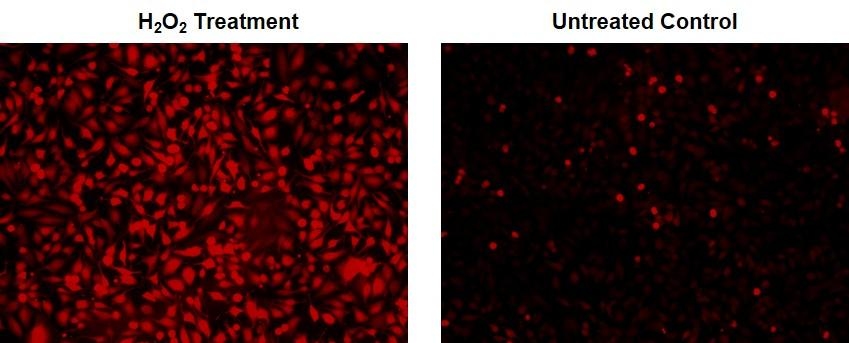ROS Brite™ DHCF
Reactive oxygen species (ROS) are chemically reactive molecules containing oxygen. Examples include superoxide, hydroxyl radical, singlet oxygen and peroxides. ROS is highly reactive due to the presence of unpaired valence shell electrons. ROS forms as a natural byproduct of the normal metabolism of oxygen and have important roles in cell signaling and homeostasis. However, during times of environmental stress (e.g., UV or heat exposure), ROS levels can increase dramatically. This may result in significant damage to cell structures. Cumulatively, this is known as oxidative stress. ROS Brite™ DHCF has similar redox properties to those of 2',7'-Dichlorodihydrofluorescein diacetate with significantly red-shifted spectra. ROS Brite™ DHCF is hydrolyzed by cellular esterases to generate the non-fluorescent reduced form that is then oxidized to generate the highly fluorescent free dye primarily by H2O2. ROS Brite™ DHCF might be reactive toward a broad range of oxidizing reactions that may be increased during intracellular oxidant stress. This probe can be conveniently used to monitoring cellular redox processes for multiplexing assays with FITC-labeled antibodies or GFP cell lines. The oxidized product is highly fluorescent in cells. ROS Brite™ DHCF provides a valuable tool for investigating oxidative stress in various pathologies.


| Catalog | Size | Price | Quantity |
|---|---|---|---|
| 16053 | 1 mg | Price |
Physical properties
| Molecular weight | 701.50 |
| Solvent | DMSO |
Spectral properties
| Excitation (nm) | 560 |
| Emission (nm) | 575 |
Storage, safety and handling
| H-phrase | H303, H313, H333 |
| Hazard symbol | XN |
| Intended use | Research Use Only (RUO) |
| R-phrase | R20, R21, R22 |
| Storage | Freeze (< -15 °C); Minimize light exposure |
| UNSPSC | 12352200 |
Documents
Contact us
| Telephone | |
| Fax | |
| sales@aatbio.com | |
| International | See distributors |
| Bulk request | Inquire |
| Custom size | Inquire |
| Technical Support | Contact us |
| Request quotation | Request |
| Purchase order | Send to sales@aatbio.com |
| Shipping | Standard overnight for United States, inquire for international |
Page updated on December 20, 2025

